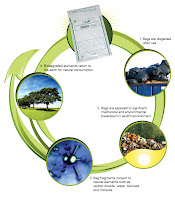One of the problems involved with creating green plastics is the amount of energy needed in production. In some scenarios, the fossil fuel input is more than what it is to create the equivalent in crude oil based plastic product.
All breakdown of the above three kinds of "green" plastics also creates carbon dioxide. We're somewhat caught between a rock and a hard place in this. The compromise appears to be using the plants that the plastic is created from also as an energy source for production.
Instead of carbon emissions being generated from sources sequestered under the ground such as coal and oil, the burning of corn stalks and other plants would not increase net carbon dioxide in the atmosphere, because new plants would absorb an equal amount of the gas.
The world of green, like any other industry, has its own language - for the person trying to make some environmentally changes to their life, it can get awfully confusing - take for instance the terms degradable, biodegradable and compostable when used in relation to plastics. There is a difference between the terms and it may play a role in your purchase decisions.
Biodegradable products break down through the action of a naturally occurring microorganism, such as bacteria, fungi etc. over a period of time. These products are usually made from plant or animal sources. Examples of biodegradable include paper, vegetable scraps and some forms of plastics made from ingredients such as corn starch.
Degradable Plastics

Degradable plastics are oil based and break down through chemical reactions rather than the activity of micro-organisms, so they can degrade in an anaerobic environment into water, CO2, biomass and trace elements.
Compostable Plastic 
This is pretty close to biodegradable plastic but "greener". According to the American Society for Testing & Materials, for plastic to be considered as compostable, it must be able to break down into carbon dioxide, water and biomass at the same rate as paper.
It also needs to look like compost, should not produce any toxic material and should be able to support plant life. Compostable items are made from plant materials such as corn, potato, cellulose, soy and sugar.
Biodegradability is determined by measuring the amount of CO2 produced over a certain time period by the biodegrading plastic. The standards require 60% conversion of carbon into carbon dioxide within 180 days for resins made from single polymer and 90% conversion of carbon into carbon dioxide for co-polymers or polymer mixes.

This is pretty close to biodegradable plastic but "greener". According to the American Society for Testing & Materials, for plastic to be considered as compostable, it must be able to break down into carbon dioxide, water and biomass at the same rate as paper.
It also needs to look like compost, should not produce any toxic material and should be able to support plant life. Compostable items are made from plant materials such as corn, potato, cellulose, soy and sugar.
Biodegradability is determined by measuring the amount of CO2 produced over a certain time period by the biodegrading plastic. The standards require 60% conversion of carbon into carbon dioxide within 180 days for resins made from single polymer and 90% conversion of carbon into carbon dioxide for co-polymers or polymer mixes.
Disintegration is measured by sieving the material to determine the biodegraded size and less than 10% should remain on a 2mm screen within 120 days.
Eco toxicity is measured by having concentrations of heavy metals below the limits set by the standards and by testing plant growth by mixing the compost with soil in different concentrations and comparing it with controlled compost.
Biodegradable - green, but can leave traces of toxins
Degradable - made from oil, but breaks down into harmless materials
Compostable - green from start to finish..
Standards
There are currently few international organizations which have established standards and testing methods for compostability, namely:
*American Society for Testing and Materials ASTM-6400-99
*European Standardization Committee (CEN) EN13432
*International Standards Organization (ISO) ISO14855
*German Institute for Standardization (DIN) DIN V49000
The ASTM, CEN and DIN standards specify the criteria for biodegradation, disintegration and eco-toxicity for a plastic to be called compostable.
For More Information Visit Us : Biodegradable-Degradable-Compostable Plastic | International Organizations | Standard Test Methods | Online Plastic B2B Portal | Plastic Research Institute
For More Information Visit Us : Biodegradable-Degradable-Compostable Plastic | International Organizations | Standard Test Methods | Online Plastic B2B Portal | Plastic Research Institute


 1:31 AM
1:31 AM



0 comments:
Post a Comment